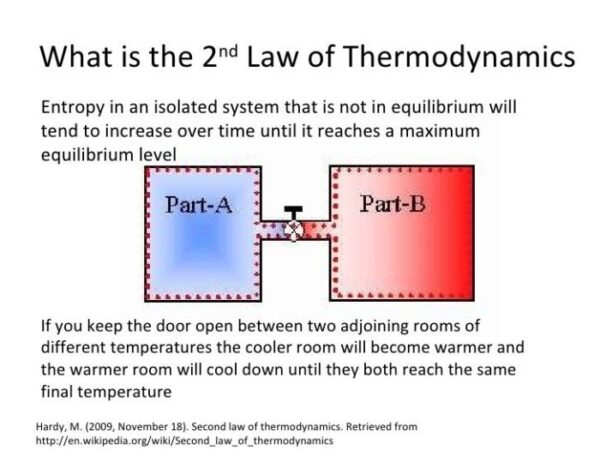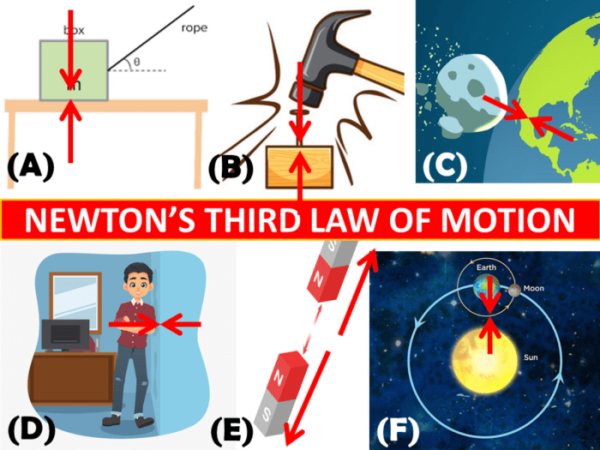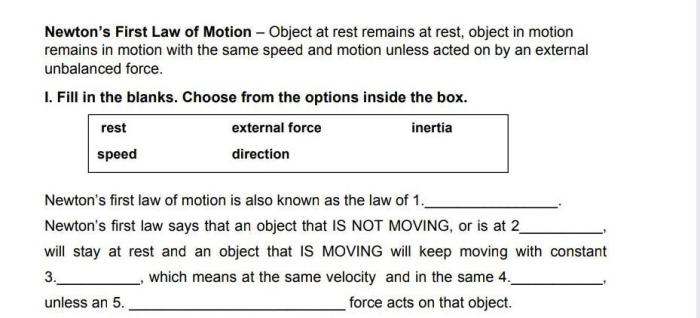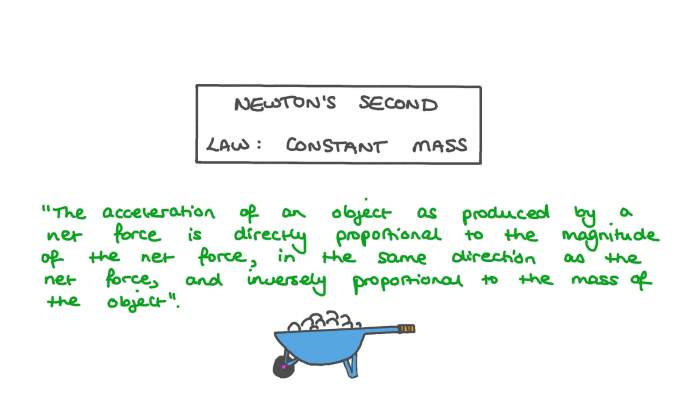
What is Newton’s First Law of Motion? This fundamental law of physics, often referred to as the law of inertia, describes the behavior of objects in motion and at rest. It states that an object at rest will remain at rest, and an object in motion will continue in motion at a constant velocity, unless acted upon by an external force. This concept, introduced by Sir Isaac Newton in the 17th century, revolutionized our understanding of the universe and continues to be a cornerstone of modern physics.
Newton’s First Law helps explain why a stationary object, like a book on a table, won’t suddenly start moving unless someone pushes it. It also explains why a moving object, like a rolling ball, won’t stop abruptly unless something like friction or a wall gets in its way. This law is essential for understanding the motion of everything from planets to cars to the smallest particles.
Introduction to Newton’s First Law

Newton’s First Law of Motion, often referred to as the Law of Inertia, is a fundamental principle in physics that describes the behavior of objects in the absence of external forces. It states that an object at rest will remain at rest, and an object in motion will continue in motion with the same speed and in the same direction unless acted upon by an unbalanced force.
Inertia, What is newton’s first law
Inertia is the tendency of an object to resist changes in its state of motion. This means that an object at rest will stay at rest, and an object in motion will continue moving at a constant velocity unless acted upon by a net force. The more massive an object is, the greater its inertia, and the more difficult it is to change its motion.
Historical Context
Sir Isaac Newton, an English physicist and mathematician, laid the foundation for classical mechanics with his three laws of motion, which were published in his groundbreaking work, *Philosophiæ Naturalis Principia Mathematica* in 1687. Newton’s laws revolutionized our understanding of how objects move and interact with each other. Before Newton, the prevailing view was that objects needed a constant force to maintain their motion, which was a concept rooted in Aristotelian physics. Newton’s First Law, however, challenged this notion, asserting that objects in motion would continue in motion unless acted upon by an external force.
The Law in Action

Newton’s First Law of Motion, also known as the law of inertia, is not just a theoretical concept. It’s a fundamental principle that governs the behavior of objects in the universe, from the smallest particles to the largest celestial bodies. This law is constantly at work in our everyday lives, shaping our experiences and influencing the design of everything from cars to buildings.
Objects at Rest
Newton’s First Law states that an object at rest will remain at rest, and an object in motion will stay in motion with the same speed and in the same direction unless acted upon by an unbalanced force. This means that for an object at rest to move, a force must be applied to it.
For example, a book lying on a table will remain at rest unless someone pushes or pulls it. Similarly, a car parked on a flat surface will not move unless the engine is started and the car is put in gear. In these cases, the force of gravity keeps the objects on the ground, while friction between the objects and the surface they are on prevents them from moving.
Objects in Motion
When an object is in motion, it will continue moving at a constant speed and in a straight line unless an unbalanced force acts upon it. This is why a ball rolling on a flat surface will eventually come to a stop. Friction between the ball and the surface, as well as air resistance, act as unbalanced forces, slowing the ball down.
The concept of inertia also explains why we feel a force pushing us back when a car suddenly accelerates. Our bodies are at rest, and when the car accelerates, the force acting on us (the car’s acceleration) causes us to feel a force pushing us back.
Examples of Newton’s First Law
The following table provides examples of how Newton’s First Law is applied in various fields:
| Field | Example | Explanation |
|————–|——————————————————————————————————————————————————————————————————————————————————————————————–|——————————————————————————————————————————————————————————————————————————————————————————————————–|
| Engineering | Designing seatbelts in cars to prevent passengers from being thrown forward during a sudden stop. | Seatbelts apply a force to the passenger, preventing them from continuing to move forward at the same speed as the car was moving before the sudden stop. This helps to reduce the risk of injury. |
| Physics | A hockey puck sliding across the ice. | The puck will continue to slide at a constant speed and in a straight line unless acted upon by an unbalanced force, such as friction from the ice or a collision with another object. |
| Everyday Life | A person riding a bicycle. | When the person stops pedaling, the bicycle will continue to move forward at a constant speed until friction from the tires and air resistance bring it to a stop. This is why we need to keep pedaling to maintain our speed. |
| Sports | A baseball thrown through the air. | The baseball will continue to move in a straight line at a constant speed until acted upon by an unbalanced force, such as gravity, air resistance, or a bat. This is why a baseball thrown straight up will eventually come back down to the ground. |
| Space Travel | A spacecraft traveling through space. | A spacecraft in space will continue to move at a constant speed and in a straight line unless acted upon by an unbalanced force, such as gravity from a nearby planet or a thruster firing to change its course. |
Applications of Newton’s First Law
Newton’s First Law is used in a wide range of applications, including:
* Engineering: Engineers use the principles of inertia to design safe and efficient structures, vehicles, and machines. For example, the design of bridges, buildings, and cars incorporates the concept of inertia to ensure stability and safety.
* Physics: Newton’s First Law is a fundamental principle in physics, used to explain and predict the motion of objects. It is used in various fields of physics, such as mechanics, astrophysics, and quantum mechanics.
* Everyday Life: The principles of inertia are at work in many aspects of our daily lives, from driving a car to playing sports. Understanding these principles helps us to make safer and more efficient decisions.
Key Concepts Related to Newton’s First Law

Newton’s First Law of Motion, often called the law of inertia, is a fundamental principle in physics that describes the behavior of objects in the absence of external forces. To fully grasp this law, it’s crucial to understand several key concepts that underpin its application and significance.
Force and Its Role in Newton’s First Law
Force is a fundamental concept in physics that describes an interaction that can change the motion of an object. It is a vector quantity, meaning it has both magnitude and direction. In Newton’s First Law, force plays a crucial role. The law states that an object at rest will remain at rest, and an object in motion will continue in motion with the same speed and in the same direction unless acted upon by an unbalanced force. This means that the absence of a net force is essential for an object to maintain its state of motion.
The Relationship Between Mass and Inertia
Inertia is the tendency of an object to resist changes in its motion. The more massive an object is, the more inertia it possesses. This means that a more massive object requires a greater force to initiate motion or to change its motion. Mass, therefore, is a measure of an object’s inertia.
The relationship between mass and inertia is directly proportional. This means that if you double the mass of an object, you also double its inertia.
Reference Frames and Their Relevance to Newton’s First Law
A reference frame is a coordinate system used to describe the position and motion of an object. The choice of reference frame can significantly impact the observed motion of an object. For instance, a person standing on a moving train might observe a ball rolling across the floor as moving in a straight line. However, a person standing outside the train would observe the ball moving in a curved path due to the train’s motion. Newton’s First Law applies within inertial reference frames, which are frames that are not accelerating.
Comparing and Contrasting Newton’s First Law with Other Laws of Motion
Newton’s First Law is one of three laws of motion that form the foundation of classical mechanics. The other two laws, Newton’s Second Law and Newton’s Third Law, also describe the relationship between force, mass, and motion.
- Newton’s Second Law states that the acceleration of an object is directly proportional to the net force acting on it and inversely proportional to its mass. This law quantifies the relationship between force, mass, and acceleration, which is not addressed in the First Law.
- Newton’s Third Law states that for every action, there is an equal and opposite reaction. This law focuses on the interaction between objects, whereas the First Law deals with the motion of a single object in the absence of external forces.
The Law in a Wider Context: What Is Newton’s First Law
Newton’s First Law, while seemingly simple, has profoundly impacted our understanding of the universe and spurred countless scientific advancements. It laid the foundation for classical mechanics, a branch of physics that describes the motion of objects under the influence of forces. This law continues to be a cornerstone of physics, influencing our understanding of everything from the motion of planets to the behavior of subatomic particles.
Impact on Our Understanding of the Universe
Newton’s First Law revolutionized our understanding of the universe by introducing the concept of inertia. Before Newton, it was widely believed that objects naturally came to rest unless acted upon by a force. Newton’s First Law challenged this notion, stating that an object in motion will stay in motion unless acted upon by an external force. This principle explained why planets continue to orbit the sun, why objects thrown in space continue to move in a straight line, and why objects at rest remain at rest. It provided a fundamental framework for understanding the motion of objects in the universe, paving the way for future discoveries in astronomy and cosmology.
Influence on Scientific Advancements
Newton’s First Law has been instrumental in countless scientific advancements. Its application in various fields has led to the development of numerous technologies, including:
- Space Exploration: Understanding inertia is crucial for launching rockets and spacecraft. The principle of inertia helps engineers design spacecraft that can navigate through space without needing constant propulsion.
- Transportation: Cars, trains, and airplanes rely on Newton’s First Law for their motion. Engines provide the force to overcome inertia and start the vehicle, while brakes use friction to slow down the vehicle.
- Manufacturing: The concept of inertia is applied in manufacturing processes like machining and metal forming. Understanding how inertia affects objects during these processes allows for more efficient and precise production.
Timeline of Key Figures and Events
Here is a timeline highlighting key figures and events related to Newton’s First Law:
- Ancient Greece (c. 350 BC): Aristotle, a Greek philosopher, proposed that objects naturally came to rest unless acted upon by a force.
- 16th Century: Nicolaus Copernicus, a Polish astronomer, proposed the heliocentric model of the solar system, which challenged the prevailing geocentric model.
- 1687: Isaac Newton publishes *Principia Mathematica*, outlining his laws of motion, including the First Law.
- 18th Century: Scientists like Leonhard Euler and Joseph-Louis Lagrange further developed Newton’s laws of motion, leading to the development of classical mechanics.
- 20th Century: Albert Einstein’s theory of relativity extended our understanding of motion and gravity, but Newton’s First Law remains a fundamental principle in many areas of physics.
Visual Representation of Newton’s First Law in Action
Imagine a hockey puck sliding across a frictionless surface. According to Newton’s First Law, the puck will continue to move in a straight line at a constant speed unless acted upon by an external force.
Last Point
Newton’s First Law of Motion is a foundational principle in physics that has profound implications for our understanding of the universe. From the movement of celestial bodies to the design of everyday objects, this law plays a vital role in shaping our world. By grasping the concept of inertia and the influence of external forces, we gain a deeper appreciation for the intricate workings of nature and the power of scientific discovery.
General Inquiries
What is the difference between inertia and mass?
Inertia is a property of an object that resists changes in its motion. Mass is a measure of the amount of matter in an object. While inertia is directly proportional to mass, they are not the same thing.
How does friction affect Newton’s First Law?
Friction is an external force that opposes motion. It acts against an object’s inertia, causing it to slow down or stop. In a frictionless environment, an object in motion would continue moving forever.
What are some real-world examples of Newton’s First Law in action?
Examples include a car continuing to move forward after the brakes are applied, a person falling forward when a bus suddenly stops, and a ball rolling across a smooth surface until it encounters an obstacle.




